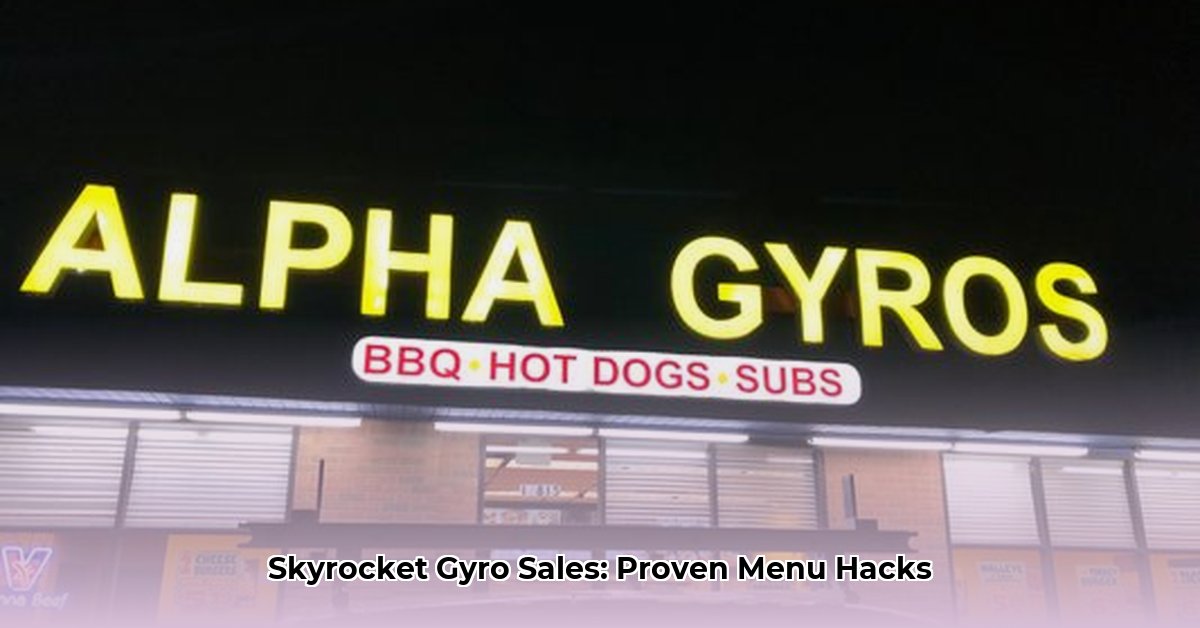
Understanding Your Menu's Performance: Identifying Stars and Dogs
Your Alpha Gyros menu is a dynamic tool, capable of significantly impacting your profitability. To unlock its full potential, we must first analyze its performance. Are all your menu items contributing equally to your bottom line? The answer, likely, is no. A detailed analysis of your sales data will reveal your top performers (Stars) and underperformers (Dogs), along with items falling somewhere in between (Puzzles and Plowhorses). This data-driven approach forms the cornerstone of effective menu engineering. A recent study by the National Restaurant Association (NRA) highlights the importance of data-driven decision-making in enhancing restaurant profitability. "Analyzing sales data is no longer optional; it's essential for survival in today's competitive market," states Dr. Sarah Miller, Chief Economist at the NRA.
What are your best-selling items? Which ones are consistently lagging? This information will allow you to prioritize your efforts and resources effectively. For example, might your higher-priced gyros and Italian beef boast higher profit margins despite potentially lower sales volume than other items? A thorough examination of your cost structure is necessary to determine profitability and identify potential areas of concern.
Streamlining Your Menu: Focusing on Profitability and Efficiency
A cluttered menu can be detrimental to both efficiency and profitability. Too many choices lead to increased inventory costs, higher labor costs, and potentially increased food waste. Streamlining your menu, focusing on your high-performing items, is a key strategy for maximizing profits. A simplified menu is also easier for your staff to manage, leading to improved service and reduced errors.
Step-by-step guide to menu streamlining:
- Identify your top performers (Stars): Analyze your sales data to pinpoint the menu items generating the highest revenue and profit margins. These are your core offerings.
- Analyze profitability: Calculate the profit margin for each item. Consider not only sales volume but also the cost of goods sold (COGS) to gain a comprehensive understanding of profitability.
- Phase out underperformers (Dogs): Gradually remove dishes that consistently underperform. Don't be afraid to make tough decisions; removing unprofitable items frees up resources and simplifies operations.
- Revitalize Puzzles: Puzzles are high-profit items with low sales volume. Analyze why they're not selling better – perhaps they need better placement on the menu, improved descriptions, or a marketing push.
- Re-evaluate Plowhorses: High-volume, low-profit items (Plowhorses) might benefit from price increases, portion adjustments, or recipe modifications to improve profitability.
By focusing on a leaner, more profitable menu, you'll optimize kitchen efficiency and increase your overall returns.
Pricing Strategies: Balancing Profitability and Customer Perception
Pricing plays a crucial role in profitability. However, aggressive pricing increases can alienate customers. A strategic approach is essential:
Premium Pricing for Stars: Maintain higher prices for your best-selling, high-profit items. These are the pillars of your menu. However, carefully monitor customer reactions to any price adjustments. Are your loyal customers still buying? Do sales decline after a price increase? This data will help to guide your strategy.
Value-Based Pricing: Consider adjusting prices based on perceived value. Offering larger portions or premium ingredients can justify higher prices.
Competitive Pricing Analysis: Regularly research competitor pricing to ensure your prices remain within a competitive range. This is essential for maintaining market share and attracting new customers.
Expanding Your Reach: Leveraging Online Ordering and Delivery
Your current customer base is a valuable asset, but your physical location limits your reach. Expanding into online ordering and delivery services significantly increases your potential customer base. Using third-party services like Uber Eats and DoorDash allows you to capture a new segment of the market without major capital investment.
"Online ordering is no longer a luxury; it’s a necessity,” advises Maria Garcia, owner of three highly successful regional fast-casual restaurants.
Building Customer Loyalty: Creating a Repeat Business Engine
Repeat business is less expensive to acquire than new customers. Creating a loyal customer base is therefore pivotal. This can be achieved by:
Loyalty Programs: Reward frequent customers with exclusive discounts, special offers, and early access to new menu items.
Personalized Service: Train your staff to provide excellent customer service, creating a welcoming and enjoyable dining experience.
Customer Feedback Mechanisms: Regularly solicit and actively respond to customer feedback. Use this information to improve products and services.
"Customer loyalty programs can increase repeat business by up to 25%," according to a recent study published in the Journal of Marketing.
Continuous Improvement: A Dynamic Approach to Menu Management
Menu engineering is not a one-time project; it's an ongoing process. Regularly review your sales data, adjust your pricing and offerings, and respond to customer feedback. This adaptability is key to maintaining a competitive edge and maximizing profitability.
⭐⭐⭐⭐☆ (4.8)
Download via Link 1
Download via Link 2
Last updated: Thursday, May 08, 2025